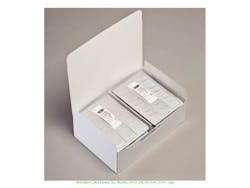Automated kitting was on the minds of some attendees at the Automate Show in Chicago last month, and vendors like Mitsubishi Electric Automation and others were happy to discuss their robotic solutions. But does it make sense to invest in automation for a kitting process that makes as few as 100 to 300 kits? Swiss pharmaceutical maker Hoffmann-La Roche AG thinks so. The company has automated the assembly of patient kits for clinical drug trials.
In an article in the January issue of Healthcare Packaging (click here, also published by Automation World’s parent, Summit Media Group Inc.), the head of clinical packaging and labeling at Hoffmann-La Roche (www.rocheusa.com) says, “For 10 years, we have had a vision of packaging the patient kits for our clinical studies using an automated process. This dream is now being fulfilled.” The article explains how Hoffman-La Roche uses a top-loading machine (TLM) packaging line made by German machine manufacturer Gerhard Schubert GmbH (www.gerhard-schubert.com). The line is reportedly so flexible it can be used to produce batch sizes of one.
Essential data management
The TLM line installed at Hoffman-La Roche—which is comprised of seven sub-machines—allots medication and placebos to individual patients and groups in predetermined quantities, and bundles them together into multipacks to form a personalized patient kit. The line handles blister packs, vials, syringes and more, and rail-based transport robots called “transmodules” enable the single-unit batch concept. But data management is actually the key, and that was much more challenging than designing and integrating the hardware.
When creating a patient kit, a specific number of products (active agent or placebo) are personalized for each patient and then packed into a box, which is also personalized. According to Gerhard Schubert, all necessary data are provided and managed by a higher-level data control system called the Schubert LMS, which communicates with the manufacturing execution system (MES) used by Hoffmann-La Roche.
Because it is not enough just to keep track of which package contains which product, the data management process goes beyond what’s known as “track and trace.” While the control process determines which product is to be packed into which box, it also uses individual data to reproduce products and boxes if they have been rejected for non-conformity. In such a case, all the required steps of the process are repeated, from retrieving a product or box to personalizing it and assigning a patient’s products to his or her kit.
Patient data is stored in an Excel spreadsheet. The successful processing of a patient kit is registered with a time stamp in the data record for the patient. Information on rejected products and packages is entered in the batch log.
This kitting line, made specifically for Hoffmann-La Roche, was shown for the first time at the Achema trade fair in May 2012. The TLM technology, including the controller, robotics, vision system, electronics, electrical system and mechanical parts are all from Gerhard Schubert, which says the transport robot and transmodules are what make it possible to simultaneously fill four boxes, erect two more and close another. Each transmodule has an ID code that makes it easier to organize processes on the single-unit batch level.
Apparently kitting can be as important as product development or process optimization. According to Urs Vögtli, Hoffman-La Roche’s equipment procurement manager, “The line does something special, even though it isn’t a customized product. This is consistent with our safety culture as a pharmaceutical manufacturer."
About the Author
Renee Bassett
Managing Editor

Leaders relevant to this article:
